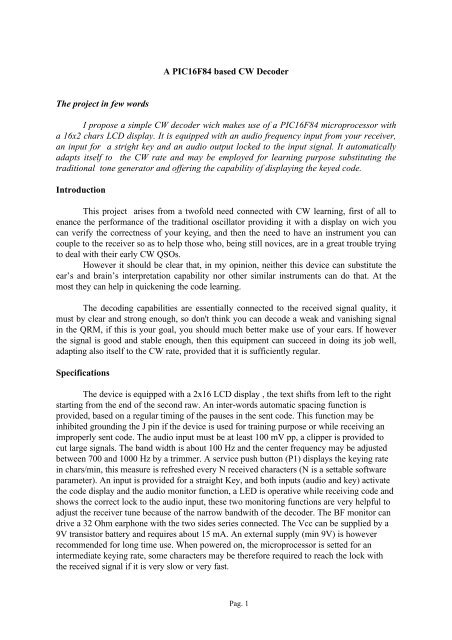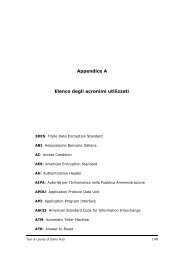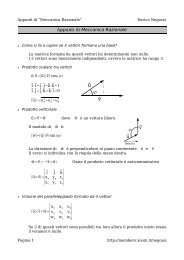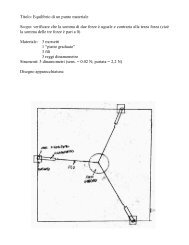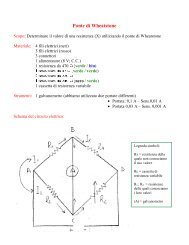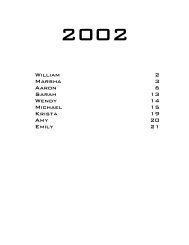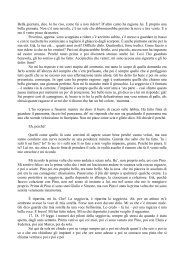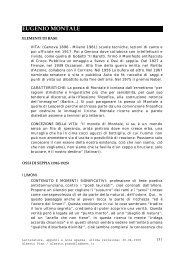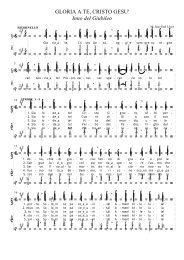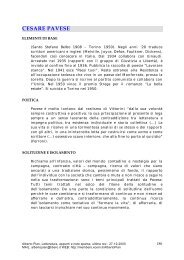A PIC16F84 based CW Decoder The project in few words I propose ...
A PIC16F84 based CW Decoder The project in few words I propose ...
A PIC16F84 based CW Decoder The project in few words I propose ...
Create successful ePaper yourself
Turn your PDF publications into a flip-book with our unique Google optimized e-Paper software.
A <strong>PIC16F84</strong> <strong>based</strong> <strong>CW</strong> <strong>Decoder</strong><br />
<strong>The</strong> <strong>project</strong> <strong>in</strong> <strong>few</strong> <strong>words</strong><br />
I <strong>propose</strong> a simple <strong>CW</strong> decoder wich makes use of a <strong>PIC16F84</strong> microprocessor with<br />
a 16x2 chars LCD display. It is equipped with an audio frequency <strong>in</strong>put from your receiver,<br />
an <strong>in</strong>put for a stright key and an audio output locked to the <strong>in</strong>put signal. It automatically<br />
adapts itself to the <strong>CW</strong> rate and may be employed for learn<strong>in</strong>g purpose substitut<strong>in</strong>g the<br />
traditional tone generator and offer<strong>in</strong>g the capability of display<strong>in</strong>g the keyed code.<br />
Introduction<br />
This <strong>project</strong> arises from a twofold need connected with <strong>CW</strong> learn<strong>in</strong>g, first of all to<br />
enance the performance of the traditional oscillator provid<strong>in</strong>g it with a display on wich you<br />
can verify the correctness of your key<strong>in</strong>g, and then the need to have an <strong>in</strong>strument you can<br />
couple to the receiver so as to help those who, be<strong>in</strong>g still novices, are <strong>in</strong> a great trouble try<strong>in</strong>g<br />
to deal with their early <strong>CW</strong> QSOs.<br />
However it should be clear that, <strong>in</strong> my op<strong>in</strong>ion, neither this device can substitute the<br />
ear’s and bra<strong>in</strong>’s <strong>in</strong>terpretation capability nor other similar <strong>in</strong>struments can do that. At the<br />
most they can help <strong>in</strong> quicken<strong>in</strong>g the code learn<strong>in</strong>g.<br />
<strong>The</strong> decod<strong>in</strong>g capabilities are essentially connected to the received signal quality, it<br />
must by clear and strong enough, so don't th<strong>in</strong>k you can decode a weak and vanish<strong>in</strong>g signal<br />
<strong>in</strong> the QRM, if this is your goal, you should much better make use of your ears. If however<br />
the signal is good and stable enough, then this equipment can succeed <strong>in</strong> do<strong>in</strong>g its job well,<br />
adapt<strong>in</strong>g also itself to the <strong>CW</strong> rate, provided that it is sufficiently regular.<br />
Specifications<br />
<strong>The</strong> device is equipped with a 2x16 LCD display , the text shifts from left to the right<br />
start<strong>in</strong>g from the end of the second raw. An <strong>in</strong>ter-<strong>words</strong> automatic spac<strong>in</strong>g function is<br />
provided, <strong>based</strong> on a regular tim<strong>in</strong>g of the pauses <strong>in</strong> the sent code. This function may be<br />
<strong>in</strong>hibited ground<strong>in</strong>g the J p<strong>in</strong> if the device is used for tra<strong>in</strong><strong>in</strong>g purpose or while receiv<strong>in</strong>g an<br />
improperly sent code. <strong>The</strong> audio <strong>in</strong>put must be at least 100 mV pp, a clipper is provided to<br />
cut large signals. <strong>The</strong> band width is about 100 Hz and the center frequency may be adjusted<br />
between 700 and 1000 Hz by a trimmer. A service push button (P1) displays the key<strong>in</strong>g rate<br />
<strong>in</strong> chars/m<strong>in</strong>, this measure is refreshed every N received characters (N is a settable software<br />
parameter). An <strong>in</strong>put is provided for a straight Key, and both <strong>in</strong>puts (audio and key) activate<br />
the code display and the audio monitor function, a LED is operative while receiv<strong>in</strong>g code and<br />
shows the correct lock to the audio <strong>in</strong>put, these two monitor<strong>in</strong>g functions are very helpful to<br />
adjust the receiver tune because of the narrow bandwith of the decoder. <strong>The</strong> BF monitor can<br />
drive a 32 Ohm earphone with the two sides series connected. <strong>The</strong> Vcc can be supplied by a<br />
9V transistor battery and requires about 15 mA. An external supply (m<strong>in</strong> 9V) is however<br />
recommended for long time use. When powered on, the microprocessor is setted for an<br />
<strong>in</strong>termediate key<strong>in</strong>g rate, some characters may be therefore required to reach the lock with<br />
the received signal if it is very slow or very fast.<br />
Pag. 1
<strong>The</strong> <strong>Decoder</strong> Software<br />
<strong>The</strong> software I developed makes use of the assembler PIC16 language and run on a<br />
<strong>PIC16F84</strong> microprocessor. It takes a measurement of the received signal ON and OFF time,<br />
obta<strong>in</strong>s some statistical mean values, and calculates three parameters wich are then used for<br />
decod<strong>in</strong>g :<br />
- Mean length of the dit/dash cycle<br />
- Mean length of the <strong>in</strong>ter-characters pause<br />
- Mean length of the <strong>in</strong>ter-<strong>words</strong> pause<br />
A flow chart of the program (macro level) is listed below<br />
START<br />
Set variables <strong>in</strong>itial value<br />
Set <strong>in</strong>put state = LOW<br />
Pressed<br />
PA1 ?<br />
Yes<br />
Display current<br />
<strong>CW</strong> speed<br />
No<br />
Signal<br />
high ?<br />
Yes<br />
No<br />
Decode last<br />
character<br />
Yes<br />
Yes<br />
Input state<br />
HIGH ?<br />
Input state<br />
LOW ?<br />
Yes<br />
LOW state<br />
duration<br />
> 2 sec<br />
No<br />
No<br />
No<br />
Set <strong>in</strong>put state = HIGH<br />
Start HIGH state timer<br />
Set <strong>in</strong>put state = LOW<br />
Start LOW state timer<br />
Refresh LOW state<br />
time count<br />
Refresh HIGH state<br />
time count<br />
No<br />
LOW state<br />
duration<br />
> Inter-chars<br />
calc. time<br />
More than 15<br />
signs received ?<br />
Yes<br />
Refresh decod<strong>in</strong>g<br />
parameters<br />
Yes<br />
No<br />
More than N<br />
chars received ?<br />
Yes<br />
Decode last<br />
sign<br />
No<br />
Refresh<br />
calculated speed<br />
Decode last<br />
character<br />
Pag. 2
Electrical Schematic<br />
R1 : 1.8 KΩ R11 : 33 KΩ C8 : 1 µF C18 : 0.5 µF<br />
R2 : 1.8 KΩ R12 : 3.3 KΩ C9 : 100 nF C19 : 100 nF<br />
R3 : 18 KΩ R13 : 18 KΩ C10 : 100 nF C20 : 100 nF<br />
R4 : 22 KΩ C1 : 47 µF - 25 Vl C11 : 220 µF U1 : <strong>PIC16F84</strong><br />
R5 : 18 KΩ C2 : 4.7 µF C12 : 22 µF U2 : 4093 CMOS<br />
R6 : 18 KΩ C3 : 100 µF C13 : 1 µF U3 : 78L05<br />
R7 : 820 Ω C4 : 100 nF C14 : 220 µF U4 : NE567<br />
R8 : 10 KΩ C5 : 82 pF C15 : 100 nF RV1-RV2 : 4.7 KΩ<br />
R9 : 10 KΩ C6 : 82 pF C16 : 100 nF D1-D2 : OA95 - AA118<br />
R10 : 10 KΩ C7 : 100 nF C17 : 1.5 µF X1 : 4 MHz xtal<br />
<strong>The</strong> schematic appears very simple, actually almost all of the functions are performed<br />
by the microprocessor software, while an NE567 tone decoder takes charge of process<strong>in</strong>g the<br />
audio <strong>in</strong>put signal. This IC conta<strong>in</strong>s a PLL circuit whose lock frequency may be adjusted<br />
between 700 and 1000 Hz by the RV2 trimmer.<br />
With the listed component values it is obta<strong>in</strong>ed a band width of about 100 Hz. <strong>The</strong><br />
m<strong>in</strong>imum accepted <strong>in</strong>put signal amplitude is 100 mV pp and its time duration would be at<br />
least 20 mS. <strong>The</strong> PLL measured lock delay is about 10 mS.<br />
A clipper is provided to limit the <strong>in</strong>put signal amplitude, it is obta<strong>in</strong>ed by 2 germanium<br />
diodes (OA95, AA118, …. not critical).<br />
A LED is connected to the p<strong>in</strong> 8 of the PLL to show the correct frequency lock. <strong>The</strong><br />
same p<strong>in</strong> 8 drives one gate (p<strong>in</strong> 2) of the CMOS trigger NAND 4093 whose output (p<strong>in</strong> 3) is<br />
connected both to the microprocessor PA0 gate and to a second CMOS gate (p<strong>in</strong> 13)<br />
Pag. 3
work<strong>in</strong>g as an audio generator. <strong>The</strong> rema<strong>in</strong><strong>in</strong>g two 4093 gates are used to implement a buffer<br />
capable of driv<strong>in</strong>g a medium impedance load (64 Ohm).<br />
A 78L05 regulator supplies both the decoder module and the LCD display, the RV1 trimmer<br />
is used to adjust the display brightness.<br />
<strong>The</strong> only required tun<strong>in</strong>g is an RV2 trimmer adjustment so as to obta<strong>in</strong> the best frequency<br />
lock us<strong>in</strong>g an <strong>in</strong>put <strong>CW</strong> signal strong and clear from your receiver<br />
Component Layout<br />
+<br />
C11<br />
VDD<br />
Vc<br />
RS<br />
E<br />
B4<br />
B5<br />
B6<br />
B7<br />
C9<br />
C10<br />
C12<br />
C8<br />
R4<br />
R9<br />
RV1<br />
U1<br />
C6<br />
C5<br />
C3<br />
C1<br />
+ +<br />
C7<br />
U3 +9V<br />
C4<br />
R3<br />
R13 R6 R8 R7<br />
R2<br />
U2<br />
C14<br />
R1<br />
J<br />
LED<br />
+<br />
KEY<br />
C2<br />
EAR<br />
+<br />
C15<br />
R10<br />
U4<br />
IN<br />
C13<br />
RV2 R12<br />
R5<br />
C16<br />
R11<br />
D1 D2<br />
X1<br />
C20<br />
P1<br />
C19<br />
C17 C18<br />
<strong>The</strong> whole circuit is mounted on a 60x80 mm PCB board. It is recommended to make<br />
use of small sized components (ceramic multilayers capacitors, low voltage electrolitics, …)<br />
so as to make easier the assembl<strong>in</strong>g. <strong>The</strong> LCD display is connected by a 10 pole flat cable<br />
soldered to 2.54 mm standard connectors, as shown below<br />
B7<br />
B6<br />
Vss<br />
Vdd<br />
Vo<br />
RS<br />
R/W<br />
E<br />
DB0<br />
DB1<br />
DB2<br />
DB3<br />
DB4<br />
DB5<br />
DB6<br />
DB7<br />
B5<br />
1<br />
14<br />
B4<br />
E<br />
RS<br />
Vss<br />
Vss<br />
Vee<br />
Vcc<br />
Pag. 4
PCB board (real dimensions)<br />
<strong>The</strong> <strong>PIC16F84</strong> development tool<br />
You may f<strong>in</strong>d several commercial development tools for the <strong>PIC16F84</strong> micro (see for<br />
example the Microchip Starter Kits). However if you are <strong>in</strong>terested <strong>in</strong> a low cost solution,<br />
you can download from the Microchip WEB site http://www.microchip2.com/<strong>in</strong>dex.html<br />
the assembler software MPASM (http://www.microchip.com/10/Tools/pTools/ MPASM/<br />
<strong>in</strong>dex.htm) and the simulator MPSIM (http://www.microchip.com/10/Tools/Archive/<br />
<strong>in</strong>dex.htm) together with the technical documentation. Regard<strong>in</strong>g to the hardware<br />
programmer construction, it is easy to f<strong>in</strong>d many references on Internet (I’ll be glad to<br />
provide some <strong>in</strong>formations). You can download a shareware version of the CIRCAD<br />
software from the Holophase WEB site http://www.holophase.com/<br />
F<strong>in</strong>al notes<br />
No particular difficulty should arise <strong>in</strong> the realization, neither <strong>in</strong> the f<strong>in</strong>d<strong>in</strong>g of the<br />
components nor <strong>in</strong> the assembl<strong>in</strong>g of the decoder. If you are <strong>in</strong>terested <strong>in</strong> obta<strong>in</strong><strong>in</strong>g more<br />
<strong>in</strong>formations, a copy of the PIC software or the CIRCAD PCB files, you may contact me at<br />
my E-mail box : ik3oil@arrl.net.<br />
Pag. 5


